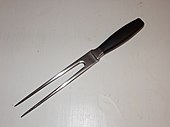carving
Carve (also Transchieren from French trancher, "Cut, disassemble") refers to the right and skillful cutting of meat , fish and poultry , but also fruit and vegetables .
When carving, a special carving set and / or poultry scissors and sometimes other aids are used.
history
It was already part of the food culture in ancient times . As people used to eat with their hands often, there was the profession of scissors in ancient Rome , who cut food into manageable pieces.
In the Middle Ages it was part of the training of a page - i.e. a candidate for a knight - or a cupbearer to master these operations. Often specially trained people also were made, which Trancheur or spurs called. Up until modern times, it was good manners for the master of the house to split and serve large roasts at the table.
Professional carving requires knowledge of the anatomy of the animals and skillful handling of the carving set . Today it is part of every good cook and waiter training course . It is common in many upscale restaurants to get a cut from the joint .
In this context, a tranche in German-speaking countries means a slice of meat about 1 cm thick. Thinner slices are called cold cuts .
Carving cutlery and other aids
The carving cutlery usually consists of a carving fork (meat fork with long prongs) (see picture) and a carving knife (large, long knife). In addition, the carving of poultry is often additionally or alternatively, a poultry shears used. When carving, the food to be cut is fixed on a carving board, which is usually made of wood.
Other special devices are:
- Sideboard knife
- Oyster knife
- Ham knife
- Fish cutlery
- Lobster tongs
- Tools for fruit and vegetable decoration, especially in Asian cuisine are used
See also
literature
- Kay-Henner Quantity: Duck & Goose: tender and crispy (= GU just cooking ). 1st edition. Gräfe and Unzer, Munich 2007, ISBN 978-3-8338-0684-1 , p. 7 ( limited preview in Google Book Search ).
Web links
Individual evidence
- ^ Werner Wilhelm Schnabel: Pre-cutting and table pleasures. Georg Philipp Harsdörffer and his “Trincirbuch” . In: Doris Gerstl (ed.): Georg Philipp Harsdörffer and the arts . Nuremberg 2006, pp. 158-174.


